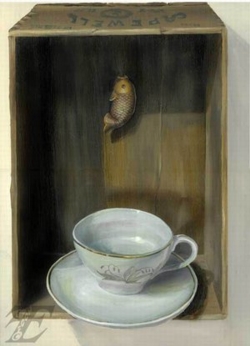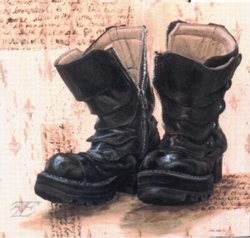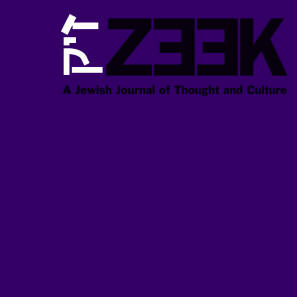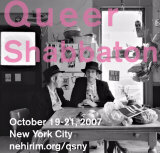 June 07
June 07
Two Excerpts from Tsalka's Alef-Bet
Dan Tsalka
|
During a recent visit to Israel I met with Jonathan Nadav, publisher of Xargol Books and friend to the late Dan Tsalka. There, in his subterranean office, we spoke about literature while rain soaked Tel Aviv’s streets overhead. It was the perfect underground setting for Jonathan to take a dramatic pause from his enthusiasms, and ask me in a conspiratorial tone if I was interested in reading translations of Tsalka, whom he considered Israel’s “best-known unknown” writer. He pressed a copy of Tsalka’s prize-winning memoir into my hands with a wink. Tsalka’s ABC [Sefer HaAlef-Bet] (Xargol, 2003) is an autobiography in alphabetical form that presents the author as his own reluctant subject. Each Hebrew letter is represented by one or more anecdotes or meditations that cumulatively create a primer on Dan Tsalka. The book retains both the charming tone of a child’s wondrous inventory of his world, and the wisdom and weariness of a gentleman raconteur. The arbitrariness of the book’s organizing principle continually reminds the reader that he is only getting part of the story, just scattershot letters from a life’s narrative given meaning by words, sentences, paragraphs – indeed, an oeuvre encompassing a score of books. And though Jewish literature reveals a long acrostic tradition in poetry and liturgy, Tsalka, who was born in Poland, was inspired to write his ABC by poet Czeslaw Milosz’s similar alphabetical memoir, Milosz’s ABC. But matters of literary affiliation aside, perhaps Jonathan was right to merely introduce me to this work with a sly smile, well aware of the pleasures it would yield to the initiate. To commemorate the second anniversary of Dan Tsalka’s death, Zeek offers its readers Vivian Eden’s graceful translations of two of Tsalka’s ABC – the “dalet” and the “nun,” which together spell the author’s first name in Hebrew.
-Adam Rovner, Hebrew Translations Editor |
Translated by Vivian Eden
“Self-Portrait at Age 27” |  |
It wasn’t easy, but one evening I started to work on a self-portrait. In order to weaken the resistance I had to writing it, I convinced myself that I wasn’t engaged in autobiography, but rather in portraiture, as though there were such a genre, as though it were possible to paint a self-portrait in words and not in lines and colors.
My fondness for the phrase “self-portrait” had its source in my youth. I loved to look at art books and I often encountered books in which there were portraits painted by the greatest artists. Under many of those portraits there were captions that explained who the person was, what his status was, and even what his character was as reflected in the portrait. But here, usually, a bitter surprise awaited me: In vain I would strain my eyes and gaze into the painted person’s face in order to discern the  characteristics attributed to him by the writer of the comments. To no avail I sought the lineaments of pride, greed, arrogance, fanaticism and the various idealisms that were mentioned there. This caused me great sorrow and also increased my insecurity. The lineaments of the face, which had been so clear to the historian, a mature and experienced individual, not only did not express the subject’s purported character to me, but also the contrary – they signaled to me the existence of other and sometimes contradictory, characteristics.
characteristics attributed to him by the writer of the comments. To no avail I sought the lineaments of pride, greed, arrogance, fanaticism and the various idealisms that were mentioned there. This caused me great sorrow and also increased my insecurity. The lineaments of the face, which had been so clear to the historian, a mature and experienced individual, not only did not express the subject’s purported character to me, but also the contrary – they signaled to me the existence of other and sometimes contradictory, characteristics.
This was not the case for “self-portraits.” The captions looked precise to me and were often amazingly clever in deciphering the strategies the painter had employed to present himself for all to see. Devotion, insolence, vanity, self-pity, self-love, dread – with respect to the self-portraits, the historians’ diagnostic acuity was not in doubt.
I loved to imagine the painter peeking into the mirror and touching his brush to the canvas. If only I could paint a self-portrait!
Mirror? Paintbrush? Canvas? I would gaze at a bottle of retsina that stood on my table, at a plate of cubed sheep’s cheese, at the glorious olives of Greece. Go, know thyself...
So many words.
A few strokes, a little paint, would have done the work in the twinkling of an eye.
“Army Boots” |  |
In very, very old psychology books that sometimes wind up in the piles of rubbish taken out of Tel Aviv buildings after a renovation or a death in the family, the term “irradiation” can be found. What causes the phenomenon of irradiation is an object that is involved in our intimate history, and which seems to radiate the past that inheres in it onto the present, thus causing what it causes in us – all according to the author of the book. It is somewhat surprising that early psychologists were prepared to deal with such literary emotions. The cinema, for which the physical presence of the object is convenient, has made good use of the phenomenon of irradiation.
There is not much to say about the phenomenon itself, but it is also hard to deny its existence, the strange connection that we have with the irradiating object. In my case, this is a long and amazingly enduring connection with a pair of shoes.
Every person who has served in the army is familiar with the importance of the shoes. It is not easy to obtain army boots that fit, and many of the military occupations are detrimental to their leather and  their durability. I did not have luck with shoes, and once I even suffered greatly from my boots when I had to participate in the Jerusalem March. But at some point half-way through my military service as a member of a tank crew exuding the smell of oil and grease, I won a tidy sum in a nocturnal poker game at a large quartermaster’s store. In exchange, I was able to select a pair of boots instead of my own, whatever I wanted. For about an hour and a half I tried on boots, until I found a wonderful pair that seemed to have been cobbled especially for me by an artisan with golden hands. There is no need to say that I took diligent care of those boots. Once every few months I would bring them to the cobbler who sat in his blackened and overflowing cubbyhole on my street. The shoemaker was a philosopher shoemaker, like Hans Sachs, even though all the songs that he would hum to himself when his radio was silent were off key.
their durability. I did not have luck with shoes, and once I even suffered greatly from my boots when I had to participate in the Jerusalem March. But at some point half-way through my military service as a member of a tank crew exuding the smell of oil and grease, I won a tidy sum in a nocturnal poker game at a large quartermaster’s store. In exchange, I was able to select a pair of boots instead of my own, whatever I wanted. For about an hour and a half I tried on boots, until I found a wonderful pair that seemed to have been cobbled especially for me by an artisan with golden hands. There is no need to say that I took diligent care of those boots. Once every few months I would bring them to the cobbler who sat in his blackened and overflowing cubbyhole on my street. The shoemaker was a philosopher shoemaker, like Hans Sachs, even though all the songs that he would hum to himself when his radio was silent were off key.
For me, reserve duty was something that separated and severed – not an adventure, but rather something that brutally truncated everything I was busy with, sometimes irreparably. My precious pair of boots was the only thing that helped me a bit. Indeed the boots already looked rather dried up and wrinkled when I would take them out of the closet. During the course of the years they had been soaked in water, they had been run over by an armored vehicle track and the leather of the right boot had peeled, but a thick layer of polish still kept them in reasonable-looking condition.
One day, in the middle of reserve duty, the shoemaker refused to deal with them. “They have to be thrown away,” he declared.
“I can’t throw these boots away!” I replied in a loud and piercing voice that startled him. I examined my precious boots: In the shoemaker’s cubbyhole, among other shoes, my boots seemed unfit even for a beggar in the street, all lumpy and cracked and full of strange distortions. The thick layer of polish looked like makeup on an old witch’s face. I knew that my shoemaker, precisely because he was an old acquaintance, would not repair my boots any more, and I went to a new shoemaker in the neighborhood, who though he demonstrated reluctance, did repair them, stitching, gluing, straightening and rounding.
I continued to wear the boots on reserve duty. During the days of the call-up for the Six Day War I noticed, with dread, quite a large hole that had gaped in the toe-cap of the right boot, but during the long time that elapsed until the war started I was able to walk around the camp in light shoes, and when at long last we set out for Jerusalem no one had time for such trivia. I didn’t gaze at my boots any more, and in fact I would look away from them until in Jericho a tank intentionally-unintentionally butted a small kiosk that stood isolated and closed. Masses of postcards spilled out of the small kiosk, which collapsed instantly. Loot? After hesitating briefly, I bent down and picked up a postcard with a photograph of the Mount of Temptation. The sight of my boots was appalling, but something fixed my gaze on them. The boots were full of a strange silence, which was apparently the famous irradiation from the psychology books. Something precious and secret was hidden in the worn leather, the holes, the protrusions and the dirty laces.
That was the first time that the irradiation had gripped me when the boots were on my feet and not in the closet.
Two years passed. I knew that there was no point in taking the boots to the shoemaker. I could not put them on, they were so dry and misshapen. I knew that I had to throw them away. I never keep more than one pair of athletic shoes and one pair of black shoes in my closet.
But I couldn’t. Regardless of what was inherent in it, it was the irradiation that had determined the existence of those boots. And what was the secret melody of my emotions? Kindness? Self-pity? The silence of a stoic?
Years later the boots were thrown away by mistake because they were in a bag that resembled a bag of old clothes. The disappearance occurred without leaving a mark.
|
Translator’s Note Whenever I think about Dan Tsalka, I think of the color blue: Dan, casual in that Tel Aviv way, shod, no doubt, in the very same single pair of athletic shoes that he mentions here, and wearing loose shorts and a blue T-shirt. At first it all seems so natural and uncontrived, but in the moment of the recognition that the T-shirt is precisely the same color as his eyes and as the late afternoon sea beyond the beach-front promenade where our chance encounter occurs, it is clear that there is great art here. Dan Tsalka had the magic touch that could transform the simplest materials into far more than the sum of their parts, and since he passed away two years ago on June 15, 2005, he has been greatly missed. -Vivian Eden |
Zeek would like to thank Jonathan Nadav for granting publication rights for this work by Dan Tsalka. To read further translations from Dan Tsalka, please visit Xargol Press.
Images: House of Tea and Boots by Felix Eddy.
Dan Tsalka was born in Warsaw in 1936. As war threatened, his family fled to the U.S.S.R., where they settled briefly in Siberia and Kazakhstan before returning to Poland at war’s end. In 1957 he immigrated to Israel. After studying Hebrew on a kibbutz and completing his military service, Tsalka studied history and philosophy at Tel Aviv University. He continued his studies in France, and later lived in England, Italy, and the Netherlands. Tsalka’s varied career saw him take up boxing, teach at several Israeli universities, edit literary and artistic publications, translate from French, and publish novels, short story collections, volumes of essays and poetry, as well as children’s literature. Among his many awards, Tsalka received Israel’s prestigious Brenner Prize, the Alterman Prize for his untranslated epic 1000 Hearts [Elef Levavot] (Am-Oved, 1991), and the Sapir Prize for Tsalka’s ABC, from which these excerpts are taken. In June of 2005, Dan Tsalka succumbed to cancer at the age of 69.
Vivian Eden holds a Ph.D. in comparative literature from the University of Iowa. She lives in Jerusalem and is on the staff of Haaretz English Edition. Among her full-length translations of fiction are Batya Gur’s Bethlehem Road Murder (HarperCollins, 2004), and Anton Shammas’s Arabesques (University of California Press, 2001), chosen by editors of the New York Times Book Review as one of the seven best books of the year when it was first published in the U.S. in 1988.









